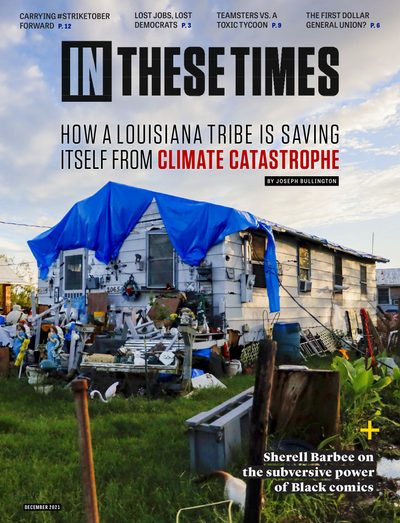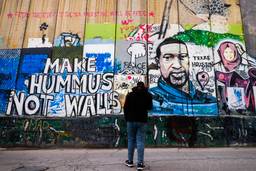The Radical History of Black Cartoonists
Meet the comic artists inking on the margins.
Sherell Barbee
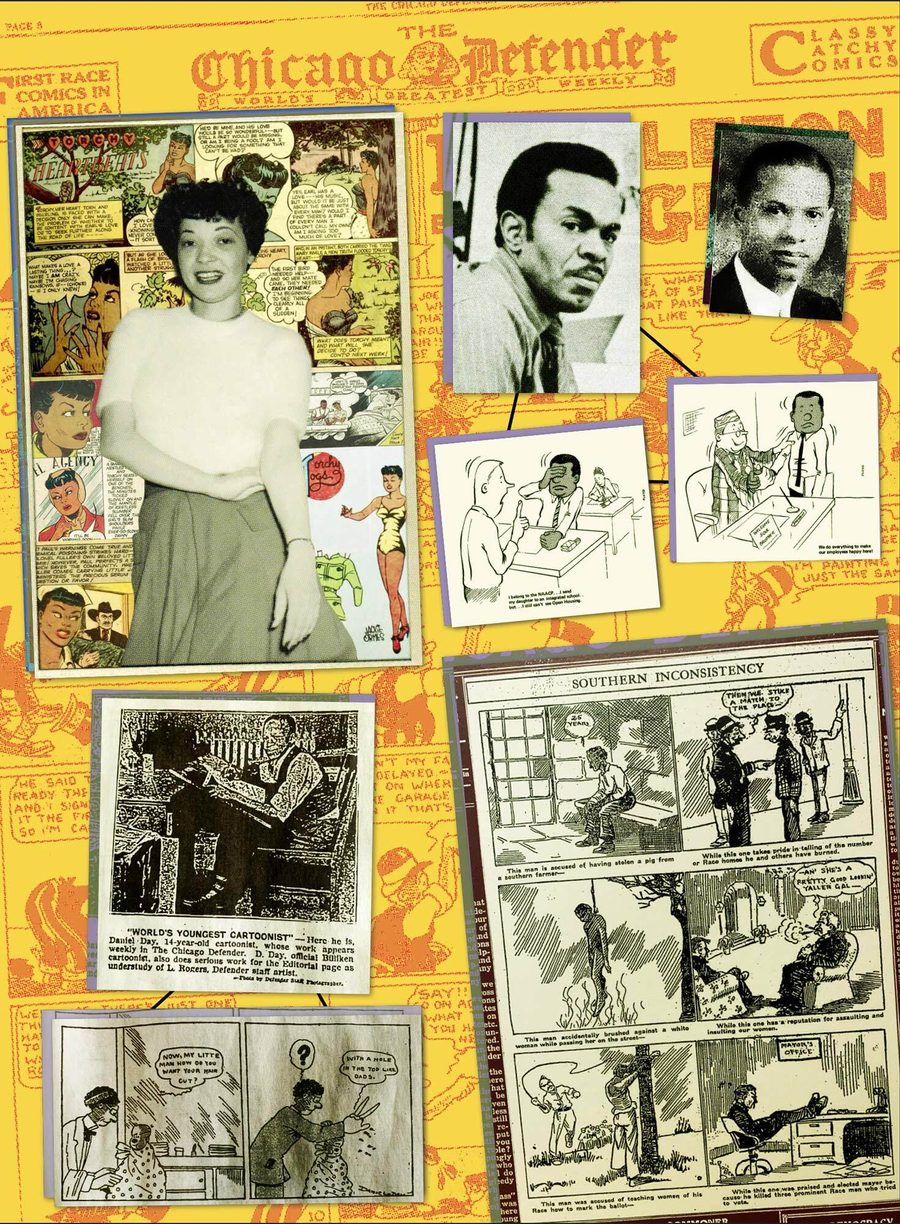
With Black writers and artists shut out of white-owned publications like the Chicago Tribune for much of the 19th and 20th centuries, the flourishing of Black-owned periodicals like the Chicago Defender, Jet and Negro Digest (renamed Black World) brought not just articles written by and for Black readers, but Black comic art. At a time when merely owning copies of the Defender was considered dangerous in parts of the South, Chicago-based artists like Leslie Rogers (1896 – 1935), Jay Jackson (1905– 1954), Jackie Ormes (1911 – 1985), Daniel Day (1913 – 2003) and Tom Floyd (1928– 2001) dared to create radical cartoons.
On exhibit at the Chicago Cultural Center until Jan. 9, 2022, Chicago: Where Comics Came to Life (1880 – 1960) dives into the origins of comic art while highlighting its lesser-known Black history. A mile away at the Museum of Contemporary Art Chicago, a related exhibit—Chicago Comics: 1960s to Now—just closed, detailing its more recent history.
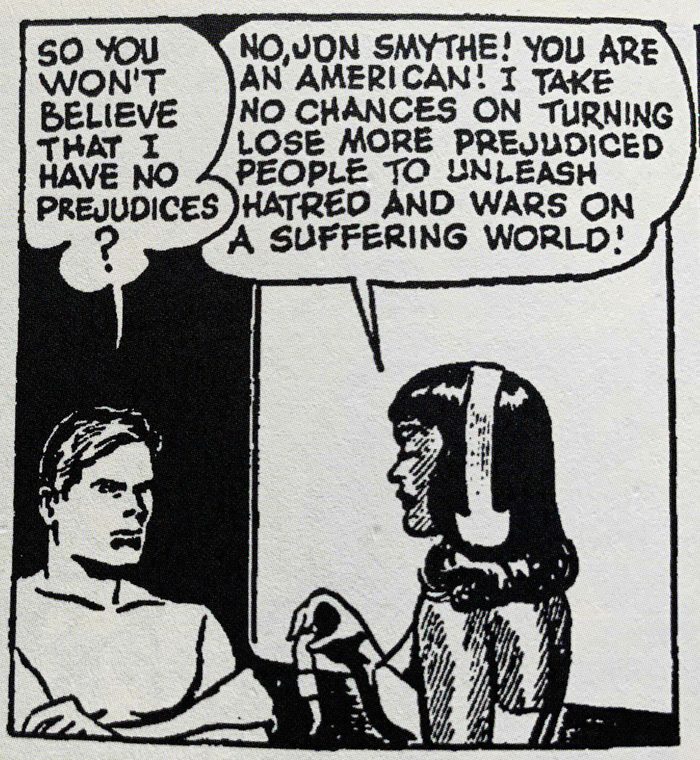
Leslie Rogers created the Bungleton Green comic in 1920, which ran into the 1960s — and still holds the record as the longest-running Black comic strip in U.S. history. After a stroke hindered Rogers’ ability to continue, Henry Brown kept the strip alive. In all, seven artists took on Bungleton, including Jay Jackson, whose 1940s run took the titular Bungleton Green on a time-traveling adventure back to 1778 (when he nearly gets killed as a rebel slave), then forward to 2044 (when green people treat white people as second-class citizens).
Daniel Day, an apprentice to Rogers, was just 14 in 1927 when his comics ran in the Defender. Day’s regular strip, Spotty, offered warm-hearted observational takes on everyday experiences. His comics career ended during World War II, when he became a lieutenant colonel in the Army.
Jackie Ormes — the first major Black woman comic artist in the United States — paired crisp lines, pointillism and Black characters donning stylish outfits with frank commentary on labor strikes, segregated schools and the Cold War. Her work was steeped in leftist politics, which put her under FBI investigation from the late 1940s to the mid-1950s.
It’s perhaps easy today to just shake our heads at the blatant hypocrisy exposed by “old” works like Tom Floyd’s 1969 comic in which a white man explains to a Black colleague how he belongs to the NAACP and sends his daughter to an integrated school but “still can’t see Open Housing.” What’s harder to swallow is the discomfort that comes when contemporary comic artists don’t sugarcoat their truth — forcing us to question ourselves, our beliefs and our self-perceived radicalism.
When people talk about the protests in Ferguson, Mo. after 18-year-old Michael Brown was killed by police officer Darren Wilson, they are quick to speak of the riots, how people looted the businesses along West Florissant Avenue, how some were burned down, how police arrived in military-grade tanks, combat gear and assault rifles, firing tear gas and rubber bullets at protesters. These are all important facets to Ferguson, but those of us who were actually there saw a fuller story.
We saw backyard barbecuers giving burgers and hot dogs to protesters. We saw prayer circles, impromptu jam bands and dancing. We saw strangers hugging while they wept.
It made for an easier news story to put things in black and white, to showcase the anger and uproar. It was too messy to show the shades of gray, to show that — brewing underneath all of it — there were people finding comfort in community after a teenager’s life and future were stolen.
In summer 2020, the New York Times asked cartoonist Ronald Wimberly for a single-page journal cartoon. He writes in the afterword to It’s Life As I See It: Black Cartoonists in Chicago, 1940 – 1980, “What resulted was a cartoon about how I felt witnessing the recent George Floyd uprisings. Ultimately, the New York Times decided not to run the cartoon on the grounds that it ‘editorialized violence.’ ”
In These Times is proud to publish here, for the first time anywhere, Wimberly’s comic, “Inside Man.” When Wimberly first sent it to me, I immediately saw the resonance with what I witnessed in Ferguson. The comic shows the violence against property that followed George Floyd’s death, explores how it made Wimberly feel and considers how people can find solace in it. Wimberly also challenges his audience to think beyond the comic, beyond their own beliefs.
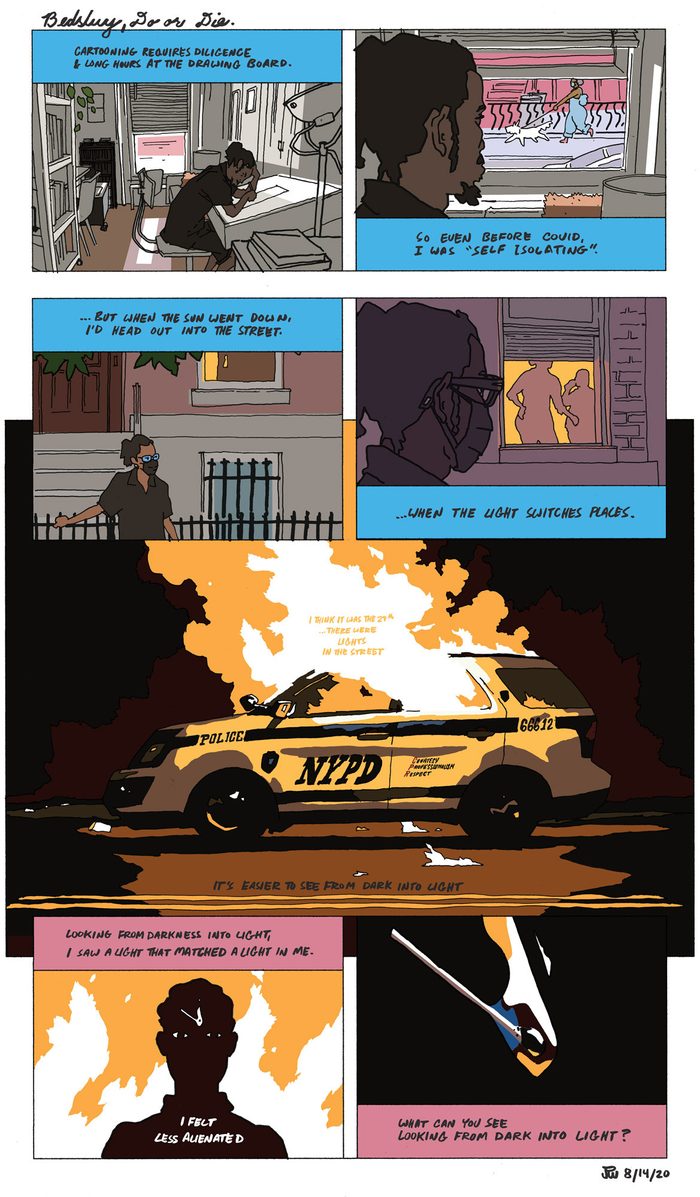
“I’ve always had a tenuous relationship with the mainstream,” Wimberly says. “I feel like they want something to amuse them in a political way, or to speak to them in a way that is affirming what they believe in, and if it goes anywhere left of that, then it’s rejected. I’ve always wondered ‘Who is this [political cartoon] for?’
“I’d rather tell stories or make things that people would find useful, entertaining or beautiful to them, more so than making liberal cartoons for liberals to pat themselves on the back or laugh at.”
The pilot episode of Aaron McGruder’s animated sitcom The Boondocks begins with a dream sequence: Huey Freeman interrupts a fancy garden party to tell a crowd of well-to-do white people that “Jesus was Black, Ronald Reagan was the devil and the government is lying about 9/11.” Within seconds, a riot ensues. Then, Huey’s grandpa slaps him awake, saying, “Having that dream where you made the white people riot, weren’t you?… How many times have I told you, you better not even dream about telling white folks the truth. You better learn how to lie like me. I’m gonna find me a white man and lie to him right now.”
My brother and I were in elementary school when The Boondocks first aired, too young to understand why someone would call Ronald Reagan the devil, why anyone would doubt the government. But the show’s raw handling of race and politics enticed us — how topics reserved just for grown folks could make us belly laugh when they fell out of the mouths of 10-year-old Huey and 8-year-old Riley.

We saw ourselves in both characters. Huey, named after the Black Panther Party’s founding leader, Huey P. Newton, is as politically conscious as his namesake. Riley, the cooler goofball of the two, always has a wisecrack ready in response to his brother’s serious musings. Soon enough, we got our hands on an anthology of The Boondocks comic strip and were forever hooked by McGruder’s tales of two Black brothers navigating a move from Chicago to a predominantly white suburb. McGruder often faced backlash throughout the comic’s 10-year run and four-season cartoon, as he inserted his leftist beliefs (often unapologetically) into his work.
Though Tom Floyd’s Integration Is a Bitch! was published in 1969, 27 years before the first strip of The Boondocks, the two seem to be in conversation, touching on the same exasperating microaggressions and head-shaking anecdotes that surface when Black and white people live and work alongside each other for the first time.
Pulling from Floyd’s experience in the white-collar workforce, Integration Is a Bitch! comments on the empty performances made by white liberals in the name of “inclusion.” In one comic, the white boss wears a dashiki, hoping the gesture makes his Black employee “feel happy.” If that seems farfetched, fast forward 50 years to when a group of Democratic lawmakers — including House Majority Leader Nancy Pelosi and Senate Majority Leader Chuck Schumer—wore kente cloths to promote the Justice in Policing Act of 2020. The legislation never advanced in the Senate and collapsed in September, proving the act performative at best.
Cartoonist Oliver Harrington (1912– 1995) described the way early white illustrators drew Black people as “a circle, black, with two hotdogs in the middle for a mouth.” Created with a white audience in mind, these characters were devoid of depth and relied on stereotypes for laughs.
“Cartooning is based in caricature, which is based on defining people by a few recognizable physical traits,” according to Dan Nadel, curator of the Chicago Comics: 1960s to Now exhibit and editor of It’s Life As I See It: Black Cartoonists in Chicago, 1940 – 1980. “As they slowly became accepted as full-fledged ‘Americans’ in the late 1930s and 1940s, the Italian, Irish, Chinese and Jewish stereotypes receded from the funny pages, but the Black stereotypes, also rooted in the visuals of minstrel performance, persisted.”
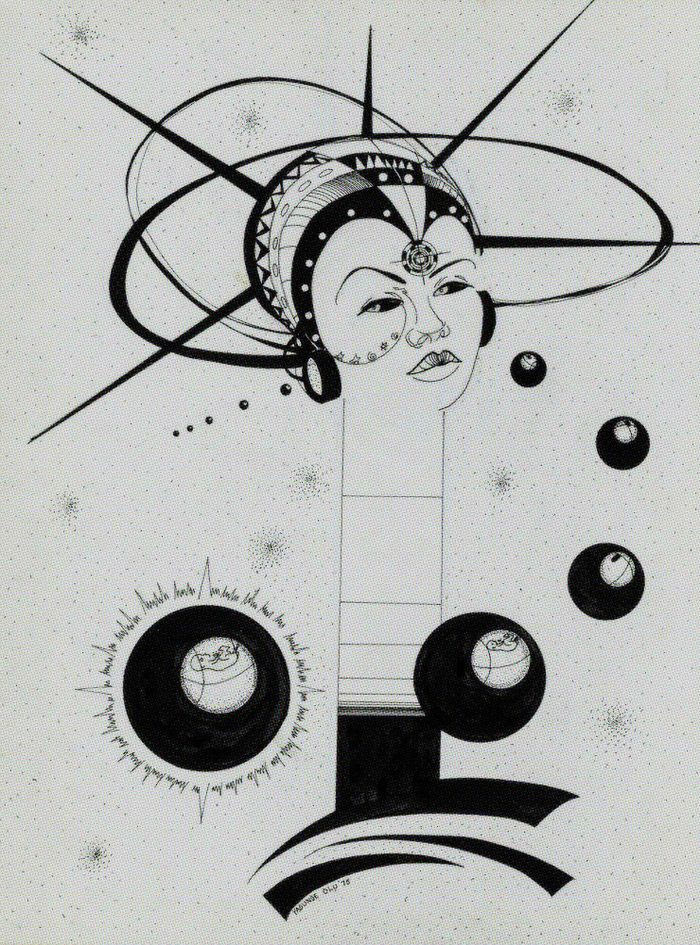
Working with Black-owned publications, Black comic artists had the freedom to create uplifting depictions of Black life, including the many dimensions of Black features, gestures and vernacular. That freedom came at a cost — Black outlets didn’t have comparable budgets to mainstream outlets and couldn’t provide artists a living wage. But these passion projects articulated the Black experience with a beauty and truth-telling that challenged the superficial images presented by mainstream white culture. They also critiqued the racism endemic in American society. We see this in some of Yaoundé Olu’s comics, which examine how (sometimes with an Afrofuturist backdrop) the United States’ misgoverning trickles into everyday realities.
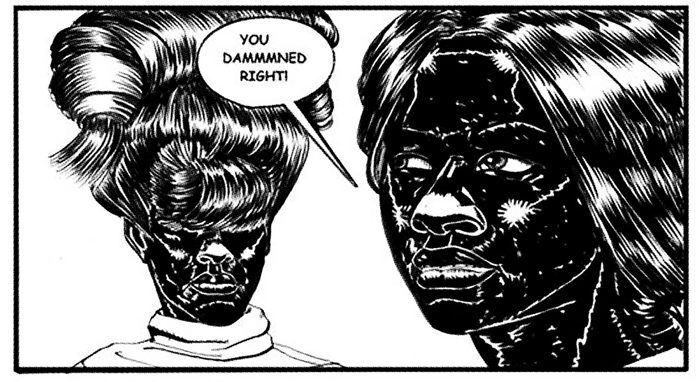
And we see it in Kerry James Marshall’s comic series Rythm Mastr, which not only focuses on Black superheroes but explores the depths of the color black itself. Instead of shying away from black, using it only to outline and shade, Marshall uses the color as a focal point that forces grays and whites to find shape around it.
“The Black body has always been a site for spectacle and entertainment, for better or worse,” Wimberly told me. “But I think because of where we are technologically — when I say ‘we,’ I mean people who see themselves in a Black framework politically — we’re able to see each other, we get to perform for each other. … It’s like a global Black lunch table.
“There’s a lot of beauty in it, there’s a lot of potential for collective problem-solving that way.”
Comics don’t exist in a vacuum. For decades, people have tapped someone, anyone, to say, “Hey, look at this,” and chuckle. Nestled between political updates and pomade ads, comics have provided us with brief moments of laughter.
In a world where videos of Black death go viral, where Black trauma narratives prevail on best-seller lists and in Hollywood films, it’s imperative we uphold art that seeks to find Black joy and comfort, whimsical and radical Black reflection.
“We should be laughing ourselves into oblivion,” Dan Nadel says. “Be aware but also have a laugh at the same time. Otherwise, it gets a little too grim, especially these days.”
Sherell Barbee is the print editor at In These Times where she also curates the culture section. Her previous editorial work includes the Missouri Review, Pleiades magazine, Speilburg Literary Agency and 826 Boston. She was a 2021 residence fellow at the Massachusetts Museum of Contemporary Art.
